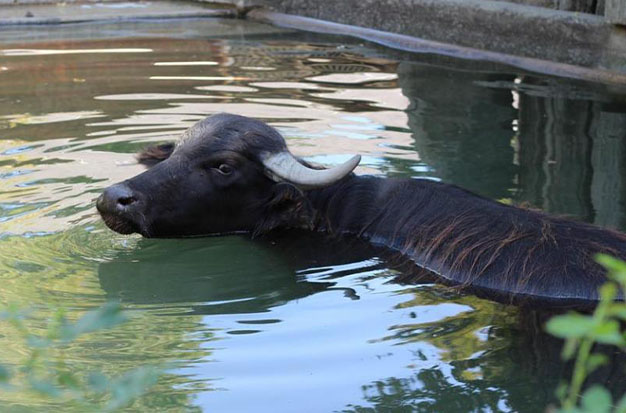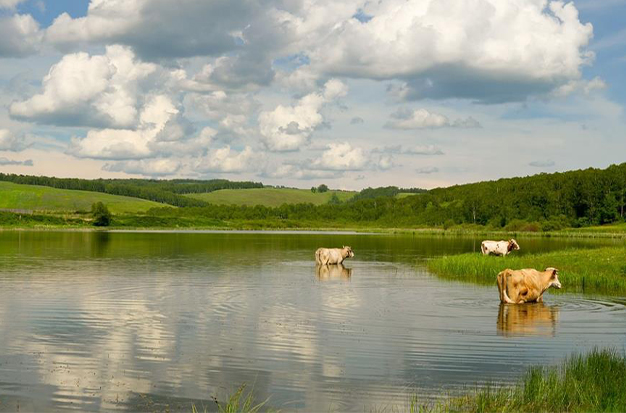Can Cows Swim? Yes! Cows Are Good At Swimming
Can cows swim? Even at a young age, cows can swim. When moving cattle to a new pasture, cowboys frequently use horses to guide the animals across rivers. Some breeds of cattle will even jump into the water and swim on their own.
Some species have a propensity or instinct to swim by nature. Cows can swim short distances, even when they are very young.
Can Cows Swim?
Cows are good swimmers, that much is true. Cows may be large and heavy, but their powerful legs keep them from sinking.
Even when they’re young, all cows are capable of swimming. In India, cows participate in cattle races that require them to cross the water as well as be corralled by cowboys through slow-moving rivers.
Cows can swim, but not very far. You must make sure there are numerous, simple entrances and exits when leading cows into the water. If not, the cows risk drowning once they become exhausted, especially if they are young.
In times of need, some adult cows have traversed lengthy distances. Similar to people, cows enjoy going swimming to stay cool during the sweltering summer months. Cows can float on the water for a brief period of time due to all of their fatty tissues.
Do Cows Enjoy Swimming?
Yes, everything indicates that cows take great pleasure in swimming. They frequently dive into the water unprompted and will also bring their kids with them. Since most cows weigh more than 1,500 pounds, swimming is probably quite relaxing for them. It’s also a natural behavior because cows don’t need to be taught how to swim, and it gives them access to more food and allows them to escape predators and cool off.
If they don’t live on a property with a pond or other accessible body of water, they may initially be afraid of the water in some cases. The cow will, however, quickly get over its apprehensions once you start exposing it to the water on a regular basis and let it swim alongside the others.
Can Cows Swim In Deep Water?
The cows that survived Hurricane Dorian wouldn’t have had much time to live if they had been pushed out to sea, right? Probably not.
That, however, has nothing to do with how deep the water is. Most cows seem to be fine in deep water, but they don’t seem to stay there for very long. Can cows submerge themselves? No, no they cannot.
Is Swimming Dangerous For Cows?
No, cows will not struggle in the water because they are proficient swimmers by nature. The only way they can get into trouble is if they tire out before they reach land, which is extremely unlikely given that most cows prefer to swim to walk and that they can typically travel for several miles in the water without getting tired. Even young calves can swim rapidly in the water without getting tired, but if there is no way out, the cow might tire out and drown.
Why Do Cows Swim?
Cows frequently use the water to get to better grazing areas, to flee from predators, and occasionally to cool off on a hot summer day. It’s common to see cows swimming during a flood, and they’ll even bring their young into the water with them.
Benefits Of Swimming For Cows
- Swimming is an excellent form of low-impact exercise
- Increased metabolism is a benefit of swimming.
- increases heart and lung health, which enhances circulation.
- Swimming reduces inflammation.
- Strengthens leg muscles
- Swimming helps to calm anxiety.
- The skin can be rehydrated by swimming.
- One cow escaped a slaughterhouse by riding a waterslide into a swimming pool.

How Do Cows Swim?
Cows walk and swim equally. Their four powerful legs serve as paddles to help them move through the water, and their enormous bodies give them the buoyancy they need to stay afloat. In fact, since their massive weight is no longer supported by their legs, most cows can swim for several miles without getting tired.
Because of their horns, cows frequently swim with their heads above the water, keeping their mouths and noses dry.
Famous Swimming Cows
Professional Athletes
Numerous farmers compete in the traditional sport of racing cattle in India. Cattle races take different forms depending on the region, but they are a long-standing custom.
Many farmers use swimming as a form of exercise to prepare their prized animals for competition. This undoubtedly lessens stress on the cow while still being a fantastic way to boost muscle tone and enhance cardiovascular performance, just like with human athletes.
The Cows Of Crom
A herd of cattle are housed on the Crom Estate in the UK, which is comprised of land that is encircled by a system of rivers that form a number of islands. These cattle are incentivized to switch pastures or grazing areas on a regular basis—sometimes even daily—by swimming across the river.
Due to their swimming prowess, the cattle can travel the 100m (328 feet) distance without any problems. More seasoned cows take the lead when introducing new calves to the herd, diving in first and encouraging the less experienced swimmers to follow and cross.
Dorian’s Disappearing Cows
In the Bahamas in 2019, Hurricane Dorian caused devastation. Even though it appeared that the Bahamas had escaped the worst of it, Dorian left a wide trail of devastation in her wake.
Just after Hurricane Dorian struck, a small herd of cattle was discovered wandering Cedar Island in North Carolina. These three cows are not native to the island, according to a park ranger.
Instead, it is thought that they likely came from the mainland and made their way to the island by swimming or floating during the storm, traveling 2 to 3 miles out to sea.
In addition to swimming nearly three miles, it appears that these cows did so in blustery conditions. An incredible achievement! (source)
So how far can cattle swim? Most cattle lack the natural ability to swim for long distances without training. During Hurricane Dorian in 2019, 3 cows were able to swim the 3 miles from North Carolina to Cape Lookout National Seashore.
Conclusion
Cows can swim and float, despite not being typically aquatic animals. Some people may even find the work enjoyable. The average person may feel much more at ease if they see a cow wading in a pond or other body of water knowing this. So the next time you see a cow cooling off, keep in mind that as long as she doesn’t seem to be in any trouble, she should be okay in the water.
Read more about:
